![]()
Methanethiol
and other stinky components of durian
![]()
![]()
Molecule of the Month May 2017
Also available: HTML version.
![]()
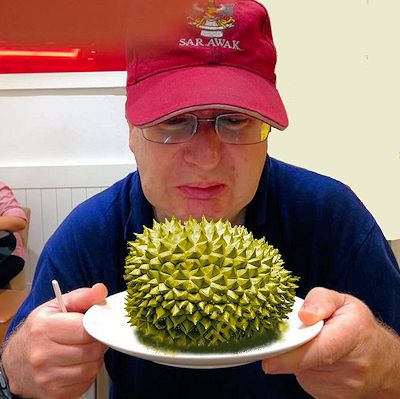
Methanethioland other stinky components of durian
Molecule of the Month May 2017
|
 |
It's a fruit found in South-East Asia that's notorious for its foul-smelling aroma. It is about the size of a small football, and covered in hard, green thorns, but inside is a yellow custard-like flesh that tastes a bit like banana crossed with mango. However, the sweet-sickly taste is often masked by its overpowering stench, which some people love, but others have likened it to a mixture of rotten onions, turpentine, and raw sewage! The novelist Anthony Burgess (famous for writing the book A Clockwork Orange) described durian as "like eating sweet raspberry blancmange in the lavatory", while food writer Richard Sterling descibed its odour as pig-excrement, turpentine and onions, garnished with a gym sock!
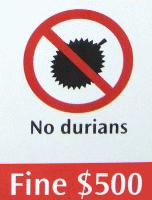
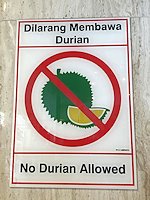
The smell of durians is so bad that it is banned on the Singapore subway
and in many hotels all over SE Asia.
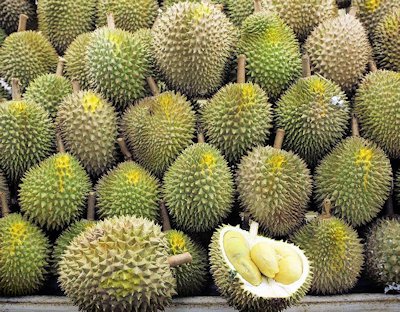 If it smells so bad why eat it?
If it smells so bad why eat it?Many people, especially those local to South-East Asia, quite like the smell. And the taste is unlike any western fruits. The British naturalist Alfred Russel Wallace in 1856 described the taste of durians as 'A rich custard highly flavoured with almonds gives the best general idea of it, but there are occasional wafts of flavour that call to mind cream-cheese, onion-sauce, sherry-wine, and other incongruous dishes...In fact, to eat Durians is a new sensation worth a voyage to the East to experience. ... as producing a food of the most exquisite flavour it is unsurpassed.'
The odour of ripe durian can be detected for many miles, depending on the wind direction, and in the wild this would attract animals, such as bats, birds, monkeys and even elephants, who would eat the fruits and then distribute the seeds in their excrement.
Analysis of the fruit by researchers Jia-Xiao Li, Peter Schieberle and Martin Steinhaus, from the German Research Center for Food Chemistry using various mass spectroscopic techniques shows that there are over 50 volatile compounds responsible for its potent aroma. Their conclusions are that it is not any single compound but instead the mixture of different chemicals that produces the fruit’s distinctive smell. Some compounds are sweet/caramel smelling (2(5)-ethyl-4-hydroxy-5(2)-methylfuran-3(2H)-one, 4-hydroxy-2,5-dimethylfuran-3(2H)-one), some are fruity (acetaldehyde, ethyl propanoate, ethyl 2-methylpropanoate), some 'skunky' ((2Z)-but-2-ene-1-thiol, 3-methylbut-2-ene-1-thiol), and some are meaty (ethane-1,1-dithiol). Some other compounds are notorious for smelling noxious. As well as the rotten-egg smell from hydrogen sulfide (see MOTM for March 2009) the main culprits seem to be thiols (also known as mercaptans), especially methanethiol, ethanethiol and propanethiol.
 |
 |
 |
| Methanethiol (rotten cabbage) |
Ethanethiol (rotten onion) |
Propane-1-thiol (rotten durian) |
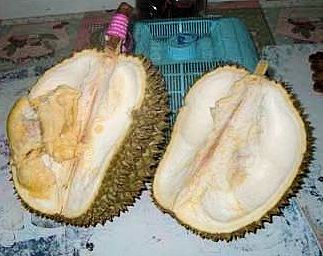 Does the smell last long?
Does the smell last long?In South-East Asia, durians are often eaten with the fingers. After eating, the person usually needs to wash their fingers and rinse out their mouth to get rid of the durian smell, otherwise it lingers all day. Even with this cleaning, a slight but detectable durian smell will still cling around the fingers and in the breath. A folk-remedy commonly used to get rid of this remaining smell involves filling a few empty durian shells (i.e. after the pulpy flesh has been scraped out and eaten) with water, and then scraping the fingers along the gooves in the shell, then washing the fingers in the water and rinsing the mouth with it too. It was thought that this was just an old-wives' tale, but recent research from the University of Indonesia in Jakarta has shed some light on why this trick may actually have a scientific basis.
The Indonesian researchers, O. Liang-Hie and M. Soemartini, passed the smell from durians through various liquids containing water rinsed through the durian shells, and found that in some cases the resulting gas no longer had the unpleasant durian aroma. They concluded that some chemical in the shells was, indeed, neutralising the durian smell. Their attention focused on aldehydes, because aldehydes are known to react with thiols to produce odourless hemithioacetals, and also because durians are known to be full of fruity aldehydes.
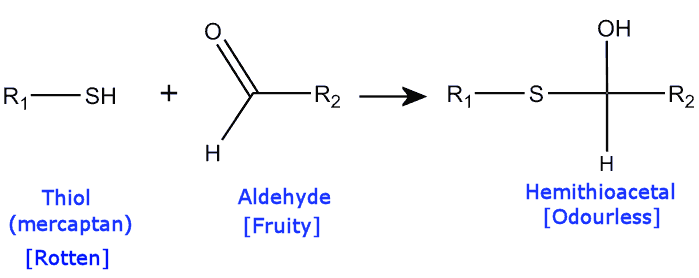
After careful analysis, the suspect was narrowed down to one particular aldehyde, 5-hydroxy-methyl-furfural (5-HMF) as being the most likely candidate. This was because it was known to be present in durian shells, and is a reasonably abundant molecule in nature becuase it is readily biosynthesised from simple sugars like hexose.
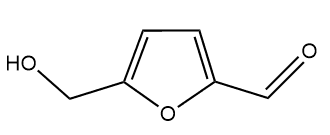 |
||
| 5-hydroxy-methyl-furfural | ||
Good question. The researchers suggest that the 5-HMF and the thiols in the durians work together during the reproductive cycle of the durian fruit. The young unripe fruit is not smelly, and this is because the 5-HMF in the shells easily neutralises the weak thiol smells from inside the fruit. This stops animals from eating the fruit too early, before its seeds are ready. As the ripening process of the fruit continues, the increasing volume of durian flesh produces a higher concentration of smelly thiols, which now overwhelm the protective coverage of the 5-HMF in the shells. The smells then start to seep through the shells indicating that the durian fruit is now ripe to be consumed, attracting animals (and humans) from the surrounding area.
 Is it true that if you drink alcohol after eating durians you may die?
Is it true that if you drink alcohol after eating durians you may die?This is a common belief in SE Asia, and it does have some scientific basis. A study by a Japanese university found that the durian's high sulfur content inhibits the activity of aldehyde dehydrogenase, an enzyme responsible for metabolising alcohol in the liver. This causes a temporary ~70% reduction of the body's ability to clear toxins, including alcohol, from the body. This is particularly ironic, as over-ripe durians begin to ferment and so become slightly alcoholic themselves, so eating these would be a doubly-whammy! It's no surprise then, that durians have obtained a reputation of being a bit of an aphrodisiac. In Indonesia they have a saying about durians (durian jatuh sarung naik), which translates as "when the durian falls, the sarong comes up"! Maybe that's also why the durian is also known as the 'King of Fruits'.
![]()
![]()